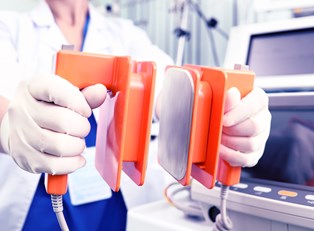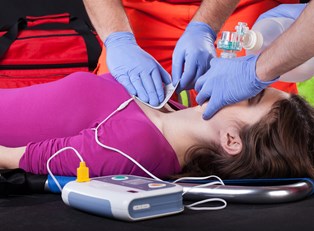Defibrillators are electronic devices used to deliver high-energy electric shocks to the heart to restore a heartbeat. Outside of the hospital there are four common ways in which defibrillators are used:
- Many patients have small implantable cardioverter defibrillators (ICDs) surgically placed within their chest.
- Other patients employ wearable cardioverter defibrillators (WCDs) as a vest.
- Automatic external defibrillators (AEDs) are portable versions that are often installed in public places.
- Some people even purchase portable AEDs for their home.
AEDs
“Stand back—all clear!” Chances are that you’ve seen automated external defibrillators used on television, at least in a hospital setting on medical shows. Portable AEDs are commonly mounted in public institutions and offices for public access. These portable units vary by the model, but overall they consist of a battery-powered box, wires that are called leads, and some adhesive electrode patches. Many AEDs include separate patches for children.
Portable AEDs are easy to operate during emergency situations and include audible prompts to guide you step-by-step through the process of placing the electrodes on a victim’s chest and administering shocks. The device will also assess whether shocks are necessary by detecting the presence of a heartbeat, and it will prompt you whether to administer shock or refrain.
Without the help of a bystander, a person experiencing sudden cardiac arrest will almost certainly die; emergency response personnel are often unable to reach the victim soon enough. Most states have Good Samaritan Laws that legally protect bystanders who assist victims by using AEDs, but it is always a good idea to familiarize yourself with the laws in your area. As with any life-threatening emergency, emergency services should be contacted before using the AED to ensure paramedics arrive as quickly as possible.
ICDs
About the size of a pad of Post-It notes, an implantable cardioverter defibrillator is used to prevent sudden cardiac arrest (SCA), a life-threatening condition in which the heart suddenly and unexpectedly stops beating. Usually, SCA is caused by a ventricular arrhythmia, an irregular heartbeat rhythm that originates in the lower muscular chambers of your heart, the ventricles. Most of the time, ICDs function like pacemakers, delivering low-energy pulses to correct less serious arrhythmias. However, should life-threatening arrhythmias occur, the ICD will send high-energy shocks to the heart to restore a regular beat.
ICDs are placed beneath the skin either in the abdomen or under the collar bone on the left side of the chest. The surgery takes just a few hours and the accompanying hospital stay is usually no more than one day. As with pacemakers, patients should take special precautions when exposed to electronics and anything with a magnetic field:
- Alert airport security of your ICD
- Alert dentists and physicians—especially before X-rays, CT scans, or MRI tests
- Do not carry electronics in the left shirt pocket
- Use cell phones with the ear furthest from the ICD
WCDs
Wearable cardioverter defibrillators, which are also referred to as "life vests," are personal defibrillators that do not require bystander assistance. WCDs are usually a temporary, noninvasive option for preventing life-threatening ventricular arrhythmias in patients who are at risk of sudden cardiac arrest. The following are a few common scenarios in which a patient is at risk of sudden cardiac arrest, but is not currently a candidate for the ICD procedure:
- a patient recovering from a heart attack when a strong recovery is expected
- a patient awaiting a heart transplant
- a patient expecting ICD surgery, but it is delayed due to an infection
- a patient recovering from heart surgery
The life vest consists of a device that is worn on a hip belt and a garment that is worn like a vest. One drawback to WCDs is that they do not provide complete protection because they cannot be worn while bathing. Another downside is that they rely on patient compliance and must be worn correctly to be effective.
WCDs can be as effective as ICDs even though they are worn on the outside of the chest. They can detect dangerous arrhythmias and deliver shock pulses, but they do not have pacemaker capabilities like ICDs do.
Home AEDs
The Sudden Cardiac Arrest Coalition (SCAC) states that as many as 80% of SCA cases occur within the home. For this reason, a growing number of patients are purchasing their own AEDs. Defibrillators for in-home use can be pricey, and insurance will likely not cover the cost. The American Heart Association recommends taking AED and cardiopulmonary resuscitation classes to learn proper techniques rather than relying on the instruction manual or audible device instructions alone. Bringing your device to your next doctor visit and discussing use with your physician is also good idea.



